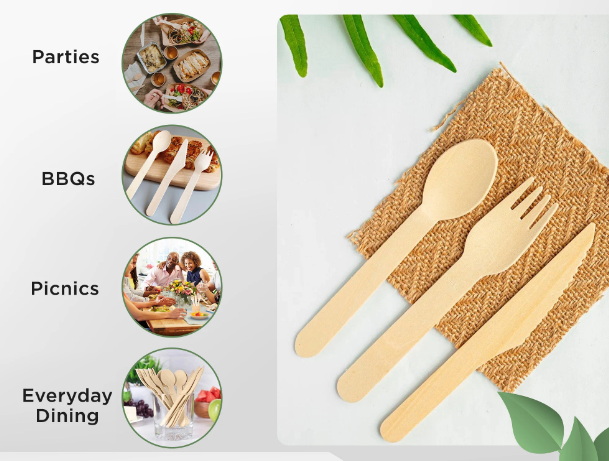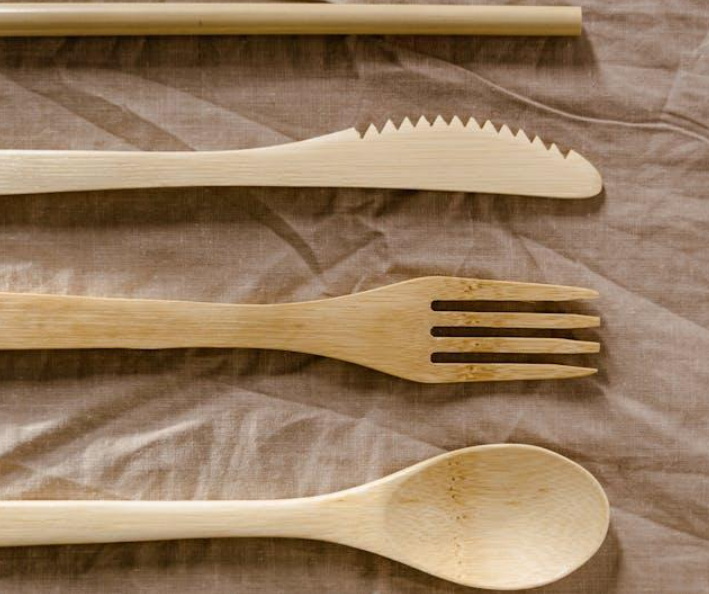
Content Menu
● Introduction to Wooden Disposable Cutlery
>> Environmental Benefits
>> Health Benefits
>> Aesthetic Appeal and Durability
>> Market Trends and Future Outlook
● Production Process of Wooden Disposable Cutlery
● Comparison with Other Materials
>> Wooden vs. Plastic Cutlery
>> Wooden vs. Compostable Plastic Cutlery
● Use Cases for Wooden Disposable Cutlery
>> Celebrations and Events
>> Food Service Industry
>> Home Use
● Challenges and Future Developments
● Conclusion
● FAQs
>> 1. Is Wooden Disposable Cutlery Compostable?
>> 2. Does Wooden Cutlery Contain Harmful Chemicals?
>> 3. Is Wooden Cutlery Durable?
>> 4. How Does Wooden Cutlery Compare to Compostable Plastic Cutlery?
>> 5. Can Wooden Cutlery Be Used for Hot Foods?
● Citations:
In recent years, the world has witnessed a significant shift towards sustainability, with consumers increasingly opting for eco-friendly products over traditional plastic alternatives. One such trend is the rise of wooden disposable cutlery, which has gained popularity due to its biodegradable nature and lower environmental impact compared to plastic. This article explores the benefits of choosing wooden disposable cutlery over plastic, including its environmental advantages, health benefits, and aesthetic appeal.

Introduction to Wooden Disposable Cutlery
Wooden disposable cutlery is made from renewable resources such as birch, bamboo, or maple wood. Unlike plastic, which can take hundreds of years to decompose, wooden cutlery is biodegradable and compostable, returning to the earth without leaving harmful residues behind. The production process of wooden cutlery requires less energy and results in fewer greenhouse gas emissions, making it a more sustainable choice for businesses and consumers alike.
Environmental Benefits
1. Biodegradability: Wooden cutlery decomposes naturally within months to years, significantly reducing landfill waste compared to plastic, which can persist for centuries[2][8].
2. Renewable Resources: Harvested from responsibly managed forests, wooden cutlery supports sustainable forestry practices and reduces the risk of deforestation[1][5].
3. Lower Carbon Footprint: The production of wooden cutlery involves fewer harsh chemicals and less energy consumption than plastic production, contributing to a cleaner environment[1][7].
Health Benefits
1. Non-Toxic: Unlike plastic utensils, which can leach harmful chemicals like BPA and phthalates into food, wooden cutlery is free from toxic substances, making it safer for consumption[1][4].
2. Natural Antibacterial Properties: Wood has inherent antibacterial properties, reducing the likelihood of bacterial contamination compared to plastic[1].
Aesthetic Appeal and Durability
1. Elegant Design: Wooden cutlery adds a natural and charming element to dining experiences, making it ideal for events and celebrations[4].
2. Strength and Sturdiness: Wooden utensils are surprisingly durable and can withstand normal use without bending or snapping[1].
Market Trends and Future Outlook
The global wooden disposable cutlery market is expected to grow significantly, driven by increasing consumer preference for sustainable products. With a projected CAGR of 5.2% from 2024 to 2030, the market is anticipated to reach a valuation of approximately USD 199.98 million by 2030[6]. This growth is fueled by the rising awareness of environmental issues, bans on single-use plastics, and the expansion of the food delivery sector[3][6].
Production Process of Wooden Disposable Cutlery
The manufacturing process of wooden cutlery involves several steps:
1. Material Sourcing: Wood is sourced from certified forests to ensure sustainability and maintain biodiversity[2].
2. Cutting and Shaping: Machines are used to cut and shape the wood into utensils, ensuring uniformity and precision[2].
3. Smoothing and Sanding: The utensils undergo smoothing and sanding to eliminate rough edges and ensure user comfort[2].
4. Treatment: Some wooden cutlery may undergo heat treatment or receive a food-grade coating to enhance safety and durability[4].

Comparison with Other Materials
Wooden vs. Plastic Cutlery
| Feature | Wooden Cutlery | Plastic Cutlery |
| Biodegradability | Biodegradable and compostable | Non-biodegradable, takes centuries to decompose |
| Material Source | Renewable resources | Non-renewable fossil fuels |
| Chemical Safety | Non-toxic, no chemical leaching | Potential for chemical leaching, especially with heat |
| Environmental Impact | Lower carbon footprint, sustainable production | High carbon footprint, contributes to plastic pollution |
Wooden vs. Compostable Plastic Cutlery
| Feature | Wooden Cutlery | Compostable Plastic Cutlery |
| Raw Materials | Renewable wood sources | Often derived from fossil fuels or cornstarch |
| Biodegradability | Naturally biodegradable | Requires specific composting conditions |
| Chemical Safety | Non-toxic | May contain additives or chemicals |
| Production Process | Less energy-intensive | More energy-intensive, relies on fossil fuels |
Use Cases for Wooden Disposable Cutlery
Celebrations and Events
Wooden cutlery is an excellent choice for various celebrations, especially if you want to reduce the environmental footprint that is common in such events. It adds a touch of elegance and sustainability to weddings, parties, and outdoor picnics[4].
Food Service Industry
The food service industry is a key end-user segment for wooden cutlery. Restaurants, cafes, and food delivery services are increasingly adopting wooden cutlery as part of their commitment to sustainability and reducing plastic waste[3].
Home Use
For households looking to reduce their environmental impact, wooden cutlery is a practical alternative to plastic. It is lightweight, compact, and easy to store, making it ideal for stocking up in homes[1].
Challenges and Future Developments
Despite its advantages, the wooden cutlery market faces challenges such as maintaining consistent quality, ensuring sustainable sourcing practices, and meeting consumer expectations for durability and affordability. To address these challenges, manufacturers are investing in advanced manufacturing techniques and collaborating with sustainable organizations to enhance their eco-friendly credentials[3][6].
Conclusion
In conclusion, wooden disposable cutlery offers a sustainable, non-toxic, and aesthetically pleasing alternative to traditional plastic cutlery. Its biodegradable nature, lower carbon footprint, and natural antibacterial properties make it an ideal choice for consumers and businesses seeking to reduce their environmental impact. As the world continues to embrace eco-friendly practices, the demand for wooden disposable cutlery is expected to grow, contributing to a cleaner and healthier planet.

FAQs
1. Is Wooden Disposable Cutlery Compostable?
Yes, wooden disposable cutlery is 100% compostable and can be composted in home or commercial facilities[4][7].
2. Does Wooden Cutlery Contain Harmful Chemicals?
No, wooden cutlery is generally free from harmful chemicals like BPA and phthalates, making it safer for consumption[1][4].
3. Is Wooden Cutlery Durable?
Yes, wooden cutlery is surprisingly durable and can withstand normal use without bending or snapping[1].
4. How Does Wooden Cutlery Compare to Compostable Plastic Cutlery?
Wooden cutlery is more sustainable due to its natural biodegradability and lower carbon footprint compared to compostable plastic cutlery, which often requires specific conditions to decompose[1][7].
5. Can Wooden Cutlery Be Used for Hot Foods?
Yes, wooden cutlery can be used for both hot and cold foods. However, waxed or treated cutlery may offer additional protection against moisture and heat[4].
Citations:
[1] https://westshorecutlery.com/disposable-wooden-cutlery/
[2] https://wonbonwood.com/life-cycle-analysis-wooden-cutlery/
[3] https://markwideresearch.com/wooden-cutlery-market/
[4] https://purpleclay.com/blogs/news/eco-friendly-wooden-disposable-cutlery-forks-spoons-knives
[5] https://kego.com.vn/the-sustainability-and-eco-friendliness-of-disposable-wooden-cutlery/
[6] https://www.verifiedmarketreports.com/product/wooden-cutlery-market/
[7] https://wonbonwood.com/disposable-wooden-cutlery-effectiveness/
[8] https://ecobravo.co.uk/blogs/blog/everything-you-need-to-know-about-wooden-cutlery
[9] https://www.futuremarketinsights.com/reports/wooden-cutleries-market
[10] https://albizpackaging.co.uk/blogs/news/8-benefits-of-using-wooden-cutlery
[11] https://www.alder-tek.com/sustainability-of-wooden-utensils-the-environmental-benefits/
[12] https://www.globenewswire.com/news-release/2025/02/10/3023429/0/en/Global-Disposable-Cutlery-Market-Projected-to-Reach-USD-2-486-3-Million-by-2035-Driven-by-Rising-Demand-for-Convenience-in-Foodservice-and-Hospitality-Sectors-FMI.html
[13] https://www.sulapac.com/blog/wooden-cutlery-pros-cons/
[14] https://justenbois.com/the-7-environmental-benefits-of-wooden-cutlery/
[15] https://www.credenceresearch.com/report/wooden-cutlery-market
[16] https://growood.in/blog-detail/disposable-wooden-cutlery-vs-plastic-cutlery-quick-comparison
[17] https://customsupplies.co.uk/blogs/news/sustainable-dining-the-rise-of-wooden-cutlery-in-eco-friendly-restaurants
[18] https://www.marketresearchintellect.com/product/disposable-wooden-cutlery-market/
[19] https://www.keeo.com.au/blogs/news/wooden-cutlery-a-healthy-and-eco-friendly-alternative-to-plastic-cutlery
[20] https://www.maisonmingle.com/2024/08/29/sustainable-living-perks-of-using-wooden-utensils-in-your-kitchen/

















